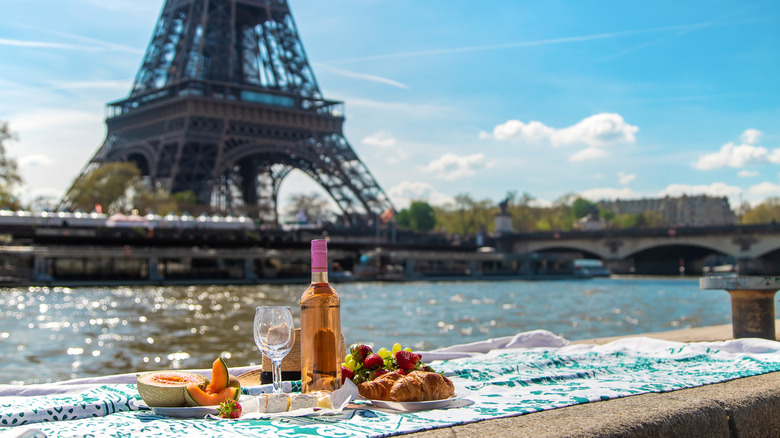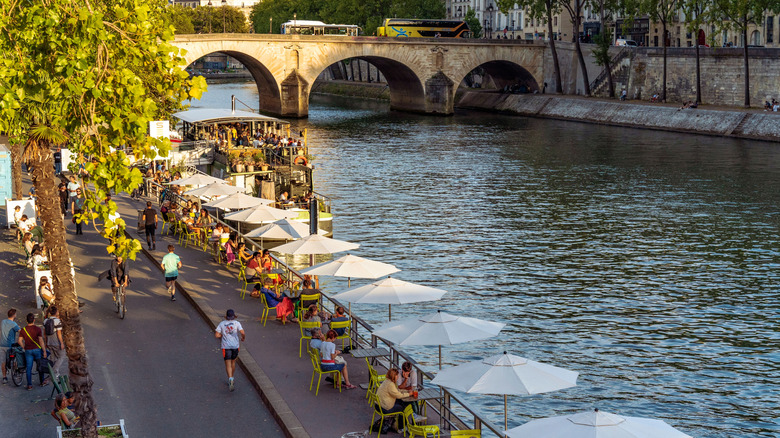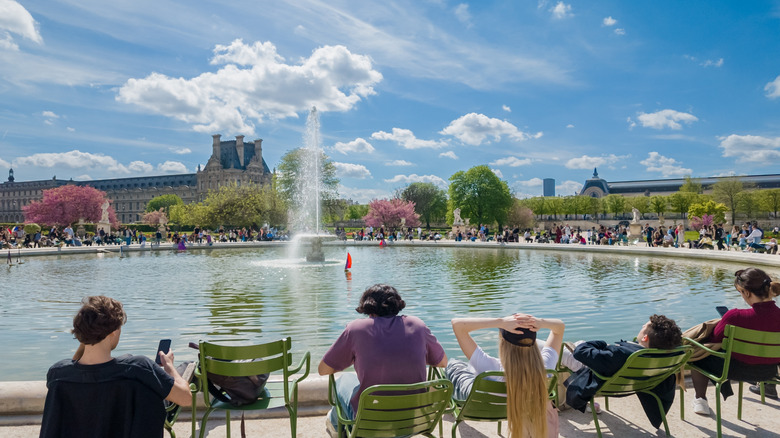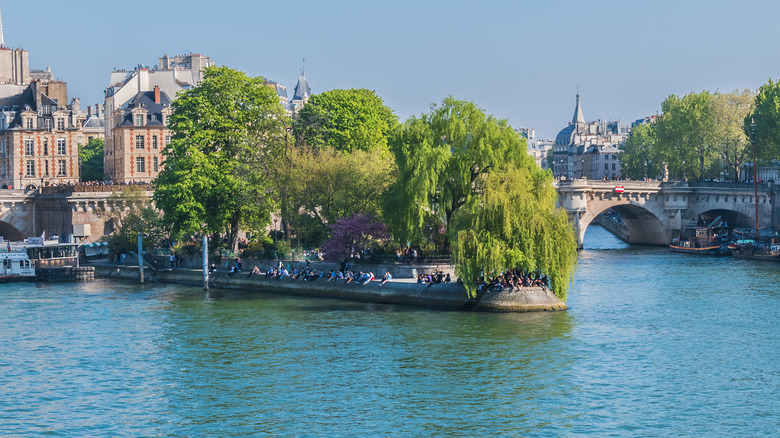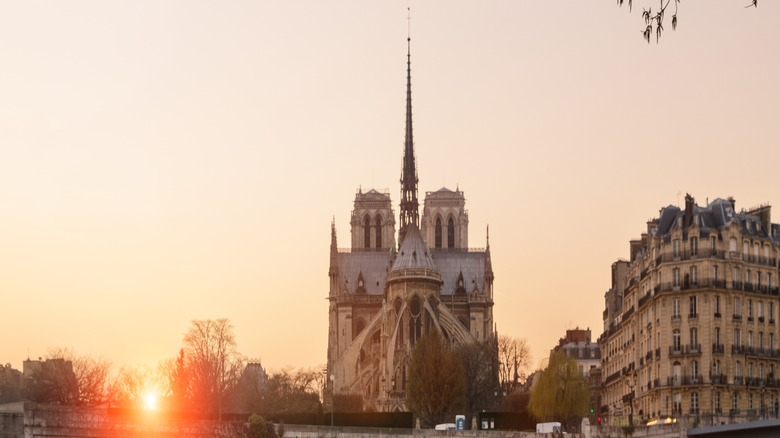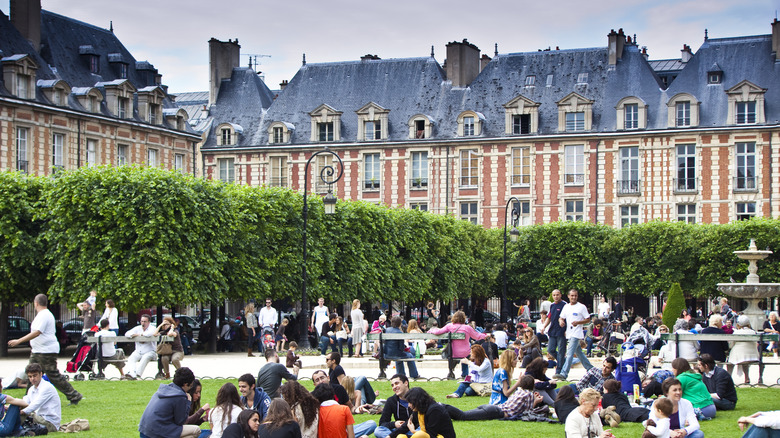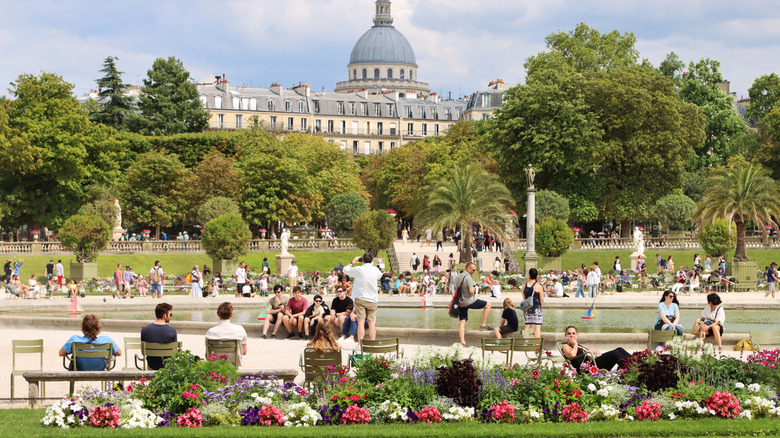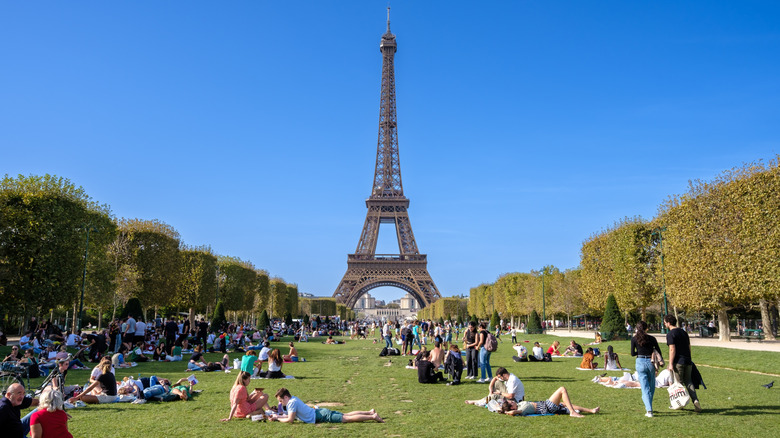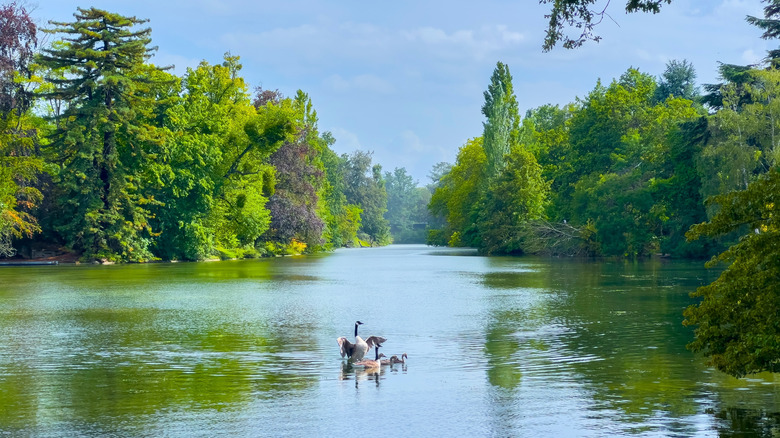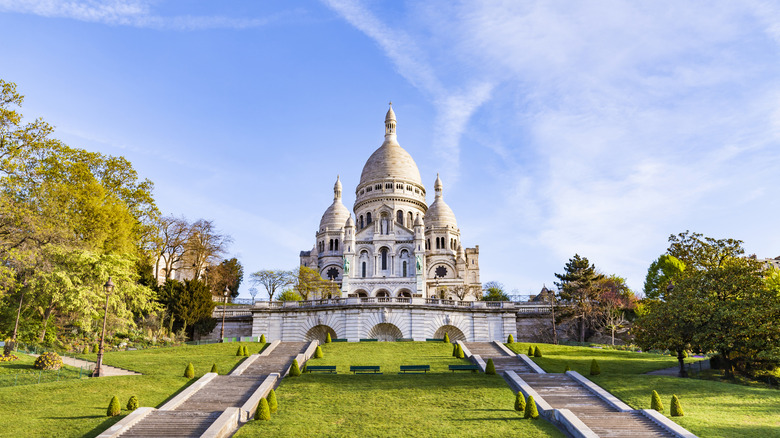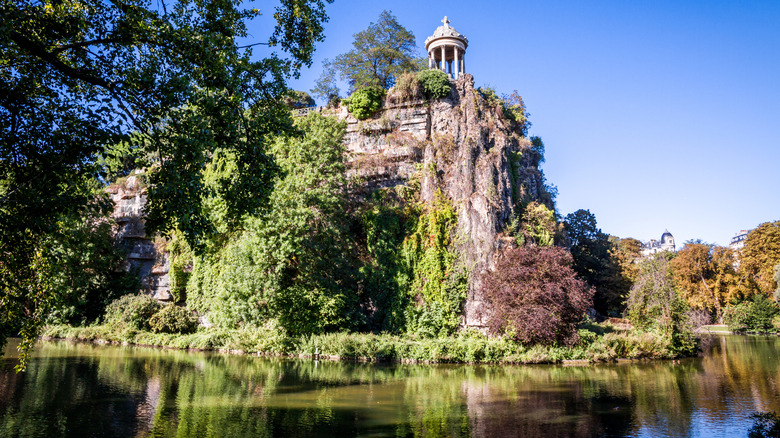The Best Places To Picnic In Paris
The French word Piquenique is a portmanteau of the words "pique," meaning "to pick at" or "nibble," and "nique," which translates to something small or trivial. As a French tradition, picnicking is bound by etiquette rules you should follow while in Paris. It was started by French aristocrats during the Renaissance period and popularized around the world in the 19th century. The picnic is as much a French export as the delicious food eaten during one. There are a few places that are more fitting for a picnic than the city where it started.
All over Paris, wherever there's a spare inch, you'll likely see people relaxing with a bottle of wine and a well-curated assortment of cheeses, meats, fruits, pastries, and, of course, a baguette. But like any French meal, you have to get the pairings just right. We searched around the City of Light for the spots that go best with your en plein air Chardonnay and Camembert. We start at the center of this circular city, then follow the clockwise spiral of arrondissements (often likened to the shape of a snail shell). Then, we end in a fairy tale park in a quiet corner off the beaten tourist path. Bon appétit!
Parc Rives de Seine
Before we visit specific picnic spots along this delightful snail shell, we have the new luxury of bringing our picnic blanket and basket to almost anywhere along what many feel is the heart and soul of Paris: the Seine. Paris was born on its banks, and many of the city's most cherished sights can still be found along its cobblestone quays, from Notre Dame to the Eiffel Tower to the Louvre to its elegant bridges. Those iconic quays, classified as a UNESCO World Heritage Site, are now full of spots to sit down with a bottle and baguette.
But less than a decade ago, it was a very different scene. A good portion of these sacrosanct quays were actually highways, bringing noise and pollution to a site many felt should be reserved for activities like picnics and strolling. In April 2017, this dream came true, and now the prime stretch of the river from the Eiffel Tower to the Bastille is an extraordinary park where you can picnic, stroll, and do about a thousand other activities. The Parc Rives de Seine (Banks of the Seine Park) boasts five bocce courts, five outdoor gyms with phone charging spots, a climbing wall, a free piano, a skate park, numerous playgrounds, and even a virtual reality telescope that shows the surrounding cityscape as it appeared in 1628.
The park is a picnicking paradise, with over 13,000 square feet of newly planted lawn graced by trees and flowers. It is also full of snack stands, food trucks, and many floating restaurants and bars. Here's your detailed guide to spending time by The Seine like a local.
Jardin de Tuileries
One of the most famous sites along the Seine is the Louvre, a world-famous art museum and former royal palace in the center of the circle. (See how to explore the Louvre efficiently.) Next to the Louvre was the Tuileries Palace, a grand palace built by Catherine de Medici in 1564 on the site of a former tile factory (hence the name.) King Louis XIV transformed portions of it into gardens; after the French Revolution, they were converted into the city's first free public park. Following the Tuileries Palace burning in a subsequent revolution in 1871, its gardens were expanded into a massive park. It remains a prime spot to breathe, relax, and celebrate in the heart of the city.
The 63-acre park is a verdant oasis on the Seine between the Louvre and the Place de la Concorde. Its prime location affords views of the river, the Eiffel Tower, the Arc de Triomphe, the Seine, and its many trees, flowers, fountains, and giant Ferris wheel. The only thing that can improve these views is a delicious croque-monsieur and a crisp glass of wine. The Tuileries is a popular picnic spot, boasting numerous chairs and benches and a number of on-site restaurants and cafés. You can enjoy classic French food at Café des Marronniers and La Terrasse de Pomone, both traditional brasseries nestled in the heart of the park. Vendors all around the park sell ice cream, crêpes, and drinks; the Boulangerie Eric Kayser offers delicious baguettes.
For an explosion of options, visit during the park's two seasonal festivals. In July and August, the Fête Foraine des Tuileries offers a full amusement park and numerous food vendors. In November and December, the Christmas Market offers more rides and cozy options like roasted chestnuts and mulled wine. Check out where to find the most festive Christmas markets in Paris.
Square du Vert-Galant
From the Tuileries, we head east and cross over the oldest bridge in Paris into the oldest neighborhood in Paris. The Pont Neuf leads to the Île de la Cité, a stunning small island home to the earliest-known Parisian settlements. As such, it is home to some of the city's most important landmarks, like the Notre Dame Cathedral and the Sainte-Chapelle Church. At the island's southern point, a teardrop-shaped sliver of green and cobblestone is crowned by maple trees and a spectacular weeping willow tree whose leaves dip gracefully into the Seine. This beloved park is Square du Vert-Galant, named after King Henry IV, who was nicknamed the "Green Gallant" due to his numerous mistresses.
Just when you thought it couldn't get any more French, visit the park at sunset when views of the Louvre and the Pont des Arts are set ablaze by the setting sun. Scores of locals bring wine, cheese, and baguettes; additionally, many couples cuddle and canoodle in this most romantic of spots. Head to the very tip of the park, underneath a commanding statue of Henry IV, and you'll feel as though you're at the hull of a boat sailing through the river.
The park is popular and small, so arrive early in the summer and on weekends for a good spot. The Ile de la Cité is full of great sites for your picnic. Walk along the Pont Neuf onto the Left Bank's Rue Dauphine, which boasts a number of boulangeries, épiceries, and boucheries, as well as restaurants offering meals à to go. Back on the island, the enchanting, teardrop-shaped Place Dauphine also has several shops, cafés, and restaurants housed in handsome brick 17th-century buildings.
Île Saint-Louis
Floating just behind the Île de la Cité is its quieter, dreamier sibling. The Île Saint-Louis may not have the grand monuments of the Île de la Cité, but it gets to look at them, making it an ideal spot for a picnic. Just behind Notre Dame (where there is another riverside park lovely for a picnic), take the Pont Saint-Louis, the bridge connecting the two islands. Pause for a minute to relish the incredible views of both islands. Don't forget to enjoy the sights of the other visible Parisian landmarks, such as the dome of the Panthéon, the Tour Saint-Jacques, and the Hôtel de Ville, the opulent city hall.
Crossing onto the Île Saint Louis, you can either turn left or right for the best picnic spots. To the right, the Quai d'Orléans provides a number of benches along cobblestone quays where you can lay a blanket. For the best spot, walk down a large pedestrian ramp, then descend another set of stairs, where you'll arrive at a secluded, shaded mini-quay offering gorgeous views of the river, Notre Dame, and the beautiful Pont de la Tournelle.
Turn left from the Pont Saint-Louis, and you'll walk along the more beautiful pedestrian quayside with benches and plenty of picnicking space along the old stone walls. At this point, Notre Dame is obscured by romantic old Parisian apartments, but they're such a lovely consolation prize you'll hardly notice. The quay continues until Place Louis Aragon, a tiny park at the far west tip of the island offering sweeping views of the river and the city. The pedestrian quay continues along the quieter north side of the island. It offers numerous spots to enjoy a baguette from the Boulangerie Saint-Louis and cheese from Guillot Fromageries under trees and graceful old bridges.
Place des Vosges
Paris is famous for its many beautiful squares, often small parklets with a fountain and flowers. Its oldest square is also one of its most spectacular Renaissance-style piazza surrounded by regal brick 17th-century architecture. Atop its perfectly symmetrical lawns, scores of Parisians laze around and enjoy gourmet food and drink from the nearby Marais neighborhood. The square was originally part of the palace of Henry II and Catherine de Medici. Henry IV converted it into a public square for a beautification project. He certainly accomplished that goal with four stone fountains, linden trees, and artfully designed walkways and bushes.
Place des Vosges is renowned as much for the 36 townhouses enclosing it as it is for its impeccable landscaping. Once home to the city's crème de la crème, these regal buildings are now home to restaurants, hotels, art galleries, and historical sites. Literature buffs from across the world travel to No. 11, a free museum once home to the famous "Les Misérables" and "Hunchback of Notre Dame" writer Victor Hugo. Art and history lovers will enjoy nearby museums like the Musée Carnavalet, which is dedicated to the history of Paris, the Musée Picasso, and the Hôtel Sully, which houses a bookstore dedicated to Parisian history and culture.
Bohemians of all stripes will love the surrounding Marais district, a famed hotspot for artists and LGBTQ nightlife. Meanwhile, architecture buffs will enjoy walking through the arcades, which are passageways under the vaulted ceilings of the Place des Vosges buildings. Some restaurants, like the Serpent à Plume, Carette, and La Place Royale, offer outdoor seating under the arcades.
Jardin de Luxembourg
We now head southwest from Le Marais into the Left Bank, long renowned for its universities and associations with artists and intellectuals like Gertrude Stein and Ernest Hemingway. Hemingway wrote lovingly of our next picnic destination, lauding it as a haven for beauty and creative inspiration.
As soon as you enter Luxembourg Gardens, you may feel compelled to dream of your next masterpiece. One of Paris' grandest, best-known parks, it is crowned by the Palais du Luxembourg, a former royal palace now home to the French Senate. Right next to the palace are the ornate Médicis Fountain from 1630 and Le Grand Bassin, a large pond buzzing with remote-control model sailboats. The rest of the 54-acre park contains tennis courts, bocce courts, playgrounds, puppet shows, and 106 statues. If you visit in the spring, the park becomes a true moveable feast of color and scent.
Many come to the Luxembourg Gardens to take part in a literal moveable feast — otherwise known as a picnic. The nearby Rue de Buci is full of great shops for wine, cheese, bread, and meats, and La Grande Épicerie food hall offers a wonderful variety of prepared meals. The park is full of meticulously trimmed lawns on which no one is allowed to sit. Most picnickers can be found on the park's iconic green chairs, picnic tables, or benches nestled under the trees. However, you'll likely see many picnickers on the grass between the rows of trees, who are bothered only by the most zealous of security guards.
Champ de Mars
Be honest: this is the one you came for. The second you read "picnic in Paris," this is what you pictured. Paris is full of one incredible landmark after another, but none have captured the world's imagination quite like the Eiffel Tower. The 1,083-foot A-shaped iron tower has become the unofficial symbol of Paris and France. You can't actually picnic inside the tower — though you can eat at Michelin-starred restaurants with unbeatable views. For a true picnic, put a blanket on the fields of the Champ de Mars, the free 60-acre park behind it.
Of course, you won't be the only one. Everyone wants to picnic by the Eiffel Tower, and this is the best spot to do it. To avoid crowds and get a good spot on the grass, travelers recommend visiting in spring or fall. During this time, crowds are smaller, but the temperatures are still reasonable, and all parts of the park are open. Travelers also recommend visiting on a weekday between 11 a.m. and 1 p.m. or between 2:00 p.m. and 4:30 p.m., when most Parisians are at work or in school.
Of course, popular tourist spots have the advantage of tailored tours and experiences. Most Parisian picnics are DIY, but because the Eiffel Tower is so popular, several companies will set up custom picnics, complete with all the best food and materials. However, if you'd like to put it together yourself, head to the many shops along the nearby market street of Rue Cler. Check out the top things you must know for your Eiffel Tower visit.
Bois de Boulogne
After the crowds of the Champ de Mars, you may need a bit of breathing space. That's exactly what you'll get at Bois de Boulogne, a 2,155-acre park far west of the city known as Paris' "Left Lung." Its Right Lung is the 2,500-acre Bois de Vincennes. It is an equally lovely park at the city's eastern edge that's just as wonderful for strolling, picnicking, and many other idyllic activities.
We only had room to include one of these massive parks, and we give a slight edge to the Bois de Boulogne due to its impressive array of amenities. Of course, plenty of open grass, chairs, and tables are available for picnics featuring delicious food from the nearby 16th arrondissement. But the park also offers 17 miles of walking paths, 9 miles of bike paths, lakes, a rose garden, an arboretum, a waterfall, an outdoor theater, an amusement park, museums, and even two Michelin-starred restaurants. If you enjoyed your picnic so much that you can't bring yourself to leave, the park also offers a 17-acre campground with 510 spots. That's a little different than the most romantic Parisian hotels, we imagine, but they're equally enchanting.
We'd need a full article to detail everything the Bois de Boulogne offers since it's over twice the size of New York's Central Park. However, one standout includes the Parc de Bagatelle, a rose garden and lily pond comprising waterfalls and peacocks. Another is the park's many lakes where you can rent boats. There's also the Grande Cascade, a massive waterfall that tumbles next to an eponymous Michelin-starred restaurant noted for its sumptuous Belle Époque styling.
Sacré-Cœur
No neighborhood evokes the Belle Époque spirit quite like Montmartre, the hilltop village once a world-famous bohemian hotspot. In the late 19th and early 20th centuries, artists like Monet, Manet, Renoir, Van Gogh, and Picasso all lived, worked, and played in the free-spirited enclave atop the city's highest point, cementing Paris' reputation as the global trendsetter in art and literature.
Today, Montmartre is a tourist hotspot, and one of its most popular spots is the grassy slopes right below the Basilique du Sacré-Cœur de Montmartre, a massive Romanesque-Byzantine basilica known for its large domes and exquisite murals. Montmartre, French for "Martyr's Mountain," towers about 350 feet over the rest of the city, making it the second highest point in Paris next to the top of the Eiffel Tower. Below the basilica are several terraced flights of stairs, each leading to a different viewing point. You can enjoy your fresh croissant or croque-monsieur on the stairs, on the grassy slopes next to the stairs, or along the many benches at the bottom of each flight.
Once you've enjoyed your delectable food, be sure to step inside the basilica, where the largest mosaic in France decorates its domed ceilings and the largest bell in France rings for special occasions. For an even better view, climb the 300 steps for stunning 360-degree views of tout Paris. Once you descend, enjoy the narrow, cobblestone streets of Montmartre that still buzz with creative, eclectic energy.
Parc des Buttes-Chaumont
For a much quieter hill, head east to Parc des Buttes-Chaumont, a dreamy Impressionist painting guarded by an ancient temple. Many of Paris' parks, like the Tuileries and Luxembourg Gardens, were designed from the 16th to 18th centuries in the Renaissance style, which emphasized rigid formality and impeccable design. But Buttes-Chaumont, perched on a hill near Paris' bohemian, multicultural Belleville neighborhood, was built in the 19th century, when the more relaxed, wild English style of landscaping was en vogue. The result is a picnicking haven offering large grassy expanses, incredible city views, and a magical gazebo perched over a waterfall.
The park is a former quarry that once supplied the limestone that makes up so many of Paris' buildings. It's named after the bare hill (Chauve Mont) that once occupied the site, and if that name doesn't sound particularly appealing, it's because the site was also a putrid industrial dumping ground. Its fortunes changed drastically in the 1860s when Napoleon III included it in his plan to incorporate parks and green spaces across the city.
Jean-Charles Alphand, the engineer behind the Bois de Boulogne and the Bois de Vincennes, transformed the quarry's 164-foot cliff into a mythical mountain, crowned by the Temple de la Sybille, a gazebo modeled after the Temple of Vesta in Italy. Below the cliff, he created an artificial lake, turning it into an enchanted island reachable only by a suspension bridge. From that bridge, you can view a waterfall tumbling down the cliff, through a grotto, and into the lake full of swans and herons. Surrounding the lake, you'll see acres of green dotted with picnic blankets, trails, trees, playgrounds, and pony rides. Paris is visible from here, as it lies beyond this breathtaking landscape.
